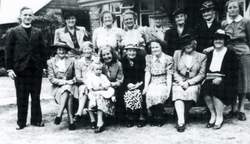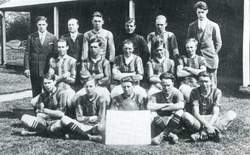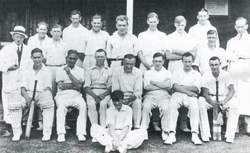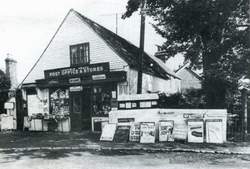Abandoned Communities ..... Lowfield Heath
Ethel Randall's mother, Mrs Jordan, worked as the school caretaker for over fifty years. Mrs P Bish, who became an assistant teacher in 1932, recalled that Mrs Jordan would have to light the fires in the school at 7.00 each morning. She would chop the wood for kindling and carry the coal in buckets from an outside shed. Another of Mrs Jordan's tasks was to clean the earth closets on the other side of the playground.
Mrs Bish continued to work at the school until after the Second World War. For a period during the war one of the classrooms was occupied by a group of Canadian soldiers. The head teacher at that time was Miss Ryde, who like her predecessor suffered long-term health problems.
All these memories are recorded in Jean Shelley's book.
Several social and religious organisations had branches at Lowfield Heath. There was a branch of the Women's Institute, a branch of the Band of Hope, known locally as the Band of Oak, and a branch of the Mothers' Union. Most of these were based in the former school building, later known as the Church Room, but some of their activities took place elsewhere. Tea parties organised by the Mothers' Union, for example, were held in the garden of Mrs Dudman's bungalow overlooking the recreation ground.
Two years after the end of the Second World War a branch of the British Legion was created in the village. It was initiated by Mr Hallett, who ran the post office and the Aero cafe. Others involved at an early stage were Major Paravicini, who lived just outside the village at Myrtle Cottage, Percy Bish, and Arthur Dudman. They discovered that 38 former service personnel lived in the village, including three women. At first members met at the Aero cafe, but within a year a club house was built along the road to Charlwood.
Various sporting activities took place in and around the village. Even before the village came into being there are records of cricket and prize fighting events on the heath itself. A cricket match in the early 1800s became famous as the occasion when Morley of the Sussex XI batted for two hours but scored just one run. The favourite location for prize fighting in the area was Crawley Down, but it also took place at Lowfield Heath. The fights were probably held at ground level without a ring or stage. Instead the crowd would have been held back by wagons.
In the twentieth century the village had clubs for cricket, football, tennis, and bowls. The football club won the Redhill and District League Sportsmanship Cup in 1930, 1932, and 1933. Quoits matches were held every Good Friday outside the White Lion.
Mrs Bish continued to work at the school until after the Second World War. For a period during the war one of the classrooms was occupied by a group of Canadian soldiers. The head teacher at that time was Miss Ryde, who like her predecessor suffered long-
All these memories are recorded in Jean Shelley's book.
Several social and religious organisations had branches at Lowfield Heath. There was a branch of the Women's Institute, a branch of the Band of Hope, known locally as the Band of Oak, and a branch of the Mothers' Union. Most of these were based in the former school building, later known as the Church Room, but some of their activities took place elsewhere. Tea parties organised by the Mothers' Union, for example, were held in the garden of Mrs Dudman's bungalow overlooking the recreation ground.
Two years after the end of the Second World War a branch of the British Legion was created in the village. It was initiated by Mr Hallett, who ran the post office and the Aero cafe. Others involved at an early stage were Major Paravicini, who lived just outside the village at Myrtle Cottage, Percy Bish, and Arthur Dudman. They discovered that 38 former service personnel lived in the village, including three women. At first members met at the Aero cafe, but within a year a club house was built along the road to Charlwood.
Various sporting activities took place in and around the village. Even before the village came into being there are records of cricket and prize fighting events on the heath itself. A cricket match in the early 1800s became famous as the occasion when Morley of the Sussex XI batted for two hours but scored just one run. The favourite location for prize fighting in the area was Crawley Down, but it also took place at Lowfield Heath. The fights were probably held at ground level without a ring or stage. Instead the crowd would have been held back by wagons.
In the twentieth century the village had clubs for cricket, football, tennis, and bowls. The football club won the Redhill and District League Sportsmanship Cup in 1930, 1932, and 1933. Quoits matches were held every Good Friday outside the White Lion.
Three
A Mothers’ Union Tea Party in the 1930s. It was held at Mrs Dudman’s bungalow overlooking Mason’s recreation ground.
Lowfield Heath football club in 1927
The cricket club in the early 1930s.
F Bettesworth appears in both of these teams. He is the goalkeeper in the football team.
These three photographs come from Jean Shelley’s book Lowfield Heath Remembered.
The opening of the British Legion club.
The Post Office and Stores




